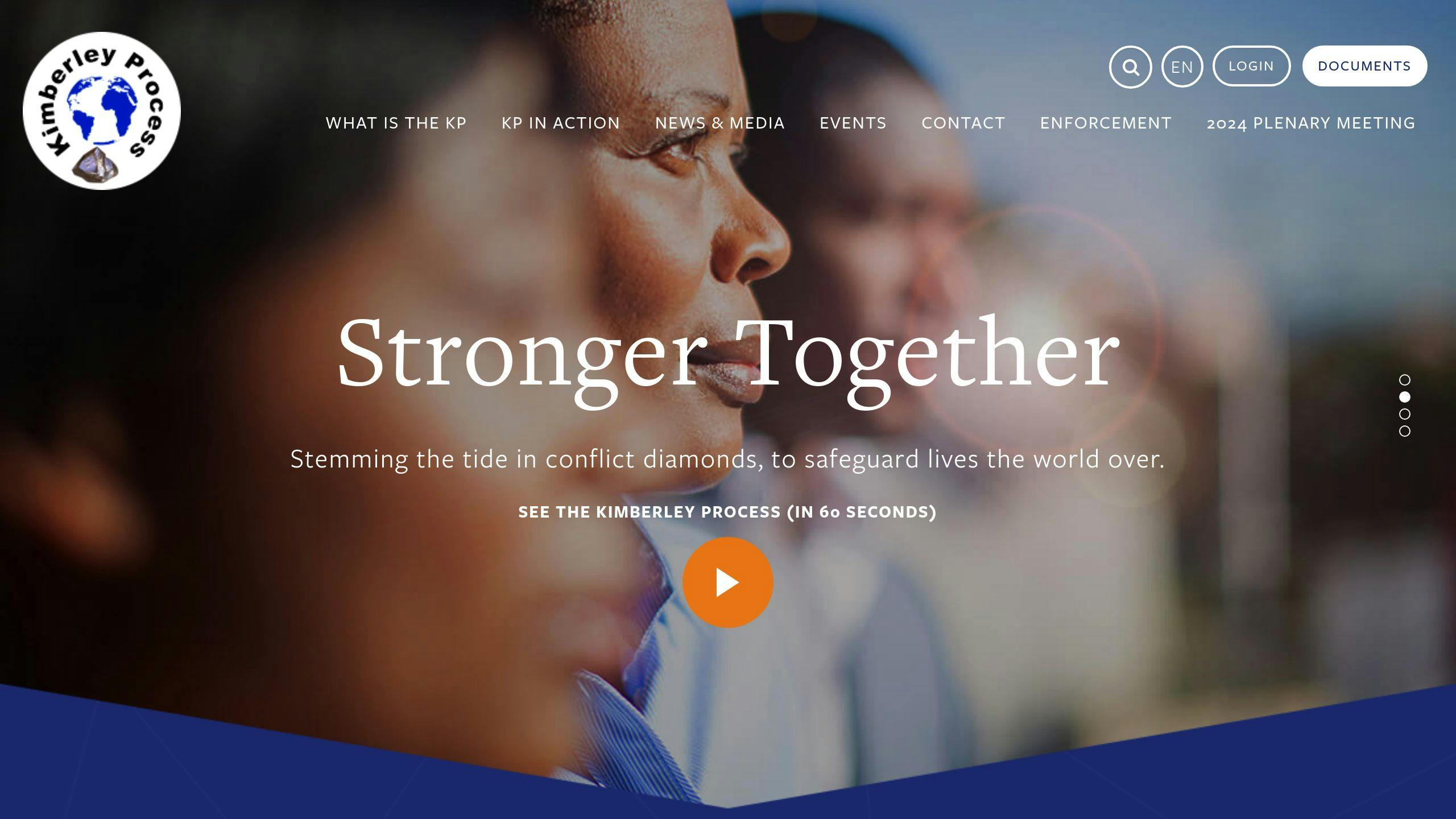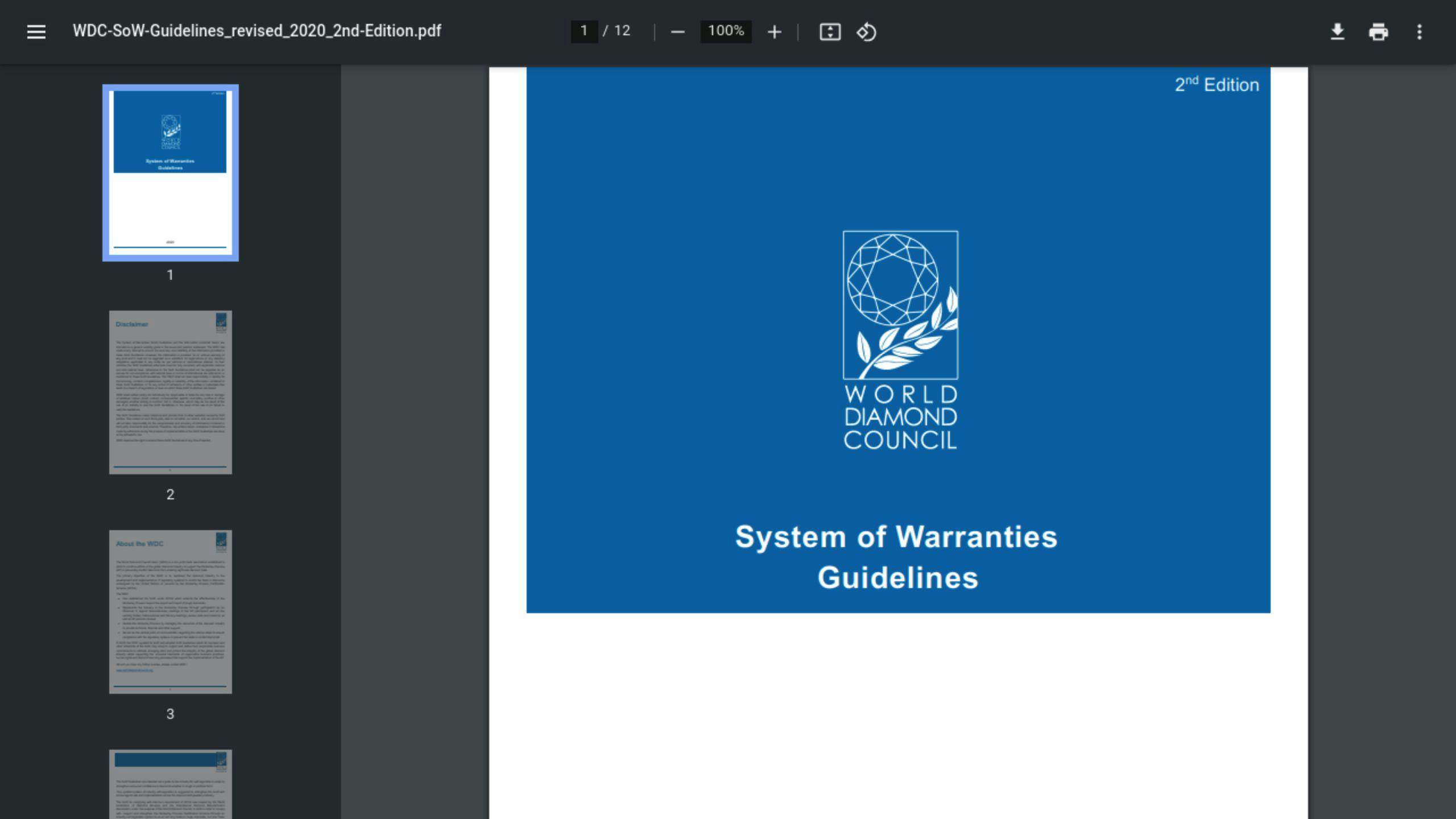Conflict-free diamond certifications aim to ensure ethical sourcing in the diamond industry. Here's what you need to know:
- The Kimberley Process (2003) is the main certification system
- It has reduced conflict diamonds from 21% to 0.2% of the market
- Other certifications include Responsible Jewellery Council and System of Warranties
- Certifications track diamonds, set ethical standards, and address environmental concerns
- They're not perfect - some issues with scope and enforcement remain
When buying certified conflict-free diamonds:
- Look for GIA or AGS certification
- Ask sellers about the diamond's origin and journey
- Consider alternatives like lab-grown or recycled diamonds
| Option | Pros | Cons |
|---|---|---|
| Certified mined | Traditional appeal | Potential ethical issues |
| Lab-grown | Ethical, cheaper | Less "natural" appeal |
| Recycled | Eco-friendly, unique | Limited availability |
The diamond industry is evolving with new tracing technologies and improved grading systems. As a buyer, your choices can support more ethical practices in the industry.
Related video from YouTube
What Are Conflict Diamonds?
Conflict diamonds, or "blood diamonds", are gems mined in war zones to fund violence. They've left a trail of human rights abuses and environmental damage.
The UN defines conflict diamonds as:
"rough diamonds used by rebel movements or their allies to finance conflict aimed at undermining legitimate governments."
These diamonds come from areas controlled by forces fighting recognized governments. The profits? They fund military actions against those governments.
This issue blew up in the 1990s, especially in war-torn African countries:
| Country | Conflict Period | Estimated Deaths |
|---|---|---|
| Sierra Leone | 1991-2002 | 50,000+ |
| Angola | 1975-2002 | 500,000+ |
| Democratic Republic of Congo | 1998-2003 | 3.7 million+ |
In these places, diamonds became a cash cow for rebel groups. The result? Forced labor, child exploitation, and widespread violence.
The world took notice. In 2003, the Kimberley Process was born. It's a certification scheme to keep conflict diamonds out of the mainstream market.
The Kimberley Process:
- Covers 85 countries
- Handles 99% of global rough diamond production and trade
- Requires transparent practices from participants
But it's not perfect. Global Witness, who first exposed this issue, says:
"Despite positive steps, the links between diamonds and abuse will only be fully broken when all companies involved in the trade change their behaviour."
The fight against conflict diamonds isn't over. There's still work to do on traceability and ethical standards in the diamond industry.
Main Conflict-Free Diamond Certifications
The diamond industry has three key certification systems to tackle conflict diamonds. Let's break them down:
Kimberley Process

The Kimberley Process Certification Scheme (KPCS) is the big player in tracking conflict-free diamonds. Launched in 2003, it's all about keeping conflict diamonds out of the market.
Here's the deal with KPCS:
- Covers 85 countries
- Handles 99% of global rough diamond production and trade
- Demands transparency from participants
But it's not perfect. The KPCS only looks at diamonds funding rebel movements against governments. It misses other forms of violence or human rights issues.
Responsible Jewellery Council

The Responsible Jewellery Council (RJC) sets ethical standards for the jewelry industry. It's not as famous as the Kimberley Process, but it's still important.
The RJC tells its members to be careful with diamonds lacking full Kimberley Process approval. In 2010, they warned about Marange diamonds:
"As is known to all Kimberley Process (KP) Participants, and as is stated in the Draft Communiqué, circulated to all participants on November 12th, 2010, the Plenary did not come to an agreement regarding KPCS arrangement for diamonds from the Marange area (Zimbabwe)." - KP Chair
System of Warranties

The System of Warranties (SoW) goes beyond the Kimberley Process. It checks that each diamond meets ethical standards from mine to store.
How it works:
- Requires a warranty statement for every diamond sale
- Connects everyone in the diamond supply chain
- Pushes for transparency in the industry
These certifications aim to ensure conflict-free diamonds, but they're not bulletproof. If you're buying diamonds, don't be shy - ask questions and do your homework.
Parts of Conflict-Free Certifications
Conflict-free diamond certifications have several key components. Let's break them down:
Tracking Requirements
Tracking is the heart of conflict-free certifications. It's about following diamonds from mine to market.
The Kimberley Process Certification Scheme (KPCS) leads the charge:
- Government-validated certificates for rough diamond exports
- Strict import/export controls
- Detailed shipment records
But KPCS has a gap: it only tracks rough diamonds. Enter the System of Warranties (SoW).
SoW requires a warranty statement on every invoice, even for polished diamonds:
"The diamonds herein invoiced have been sourced from legitimate sources not involved in funding conflict, in compliance with United Nations Resolutions and corresponding national laws."
Ethical Standards
Ethical standards go beyond conflict avoidance. They cover human rights, fair labor, and anti-corruption.
The Responsible Jewellery Council (RJC) sets high standards with third-party audits of:
- Supply chain practices
- Human rights records
- Business ethics
Environmental Factors
Ethical sourcing isn't just about people - it's about the planet too. Certifications now include environmental standards:
- Environmental law compliance
- Sustainable mining practices
- Carbon footprint reduction
Natural Diamond Council members, for example, must follow ISO 14001 for environmental management.
Worker Rights
Worker rights are crucial in ethical diamond sourcing. Certifications examine:
- Fair wages
- Safe working conditions
- No child labor
- No forced labor
The Diamond Development Initiative (DDI) focuses on improving conditions for artisanal miners, who produce about 15% of the world's diamonds but often face tough conditions.
Remember: These certifications aim for ethical practices, but they're not perfect. Buyers should still ask questions and do their homework when diamond shopping.
How Well Do Certifications Work?
Conflict-free diamond certifications aim to keep unethical diamonds out of the market. But do they actually work? Let's dive in.
Pros and Cons
| Pros | Cons |
|---|---|
| Less conflict diamonds | Limited scope (KPCS only covers rough diamonds) |
| More ethical sourcing awareness | Doesn't tackle all human rights issues |
| Government-backed (KPCS) | Global enforcement struggles |
| Better supply chain tracking | Can't track polished diamonds well |
Implementation Issues
The Kimberley Process Certification Scheme (KPCS) has hit some snags:
- Some countries can't enforce it properly
- It only targets diamonds funding rebels, ignoring other issues
- Once cut and polished, diamonds become hard to track
In 2008, over 200 miners died in Zimbabwe's diamond conflicts. Yet, Zimbabwe kept its KPCS approval. Yikes.
Current Debates
The diamond industry is wrestling with:
1. Expanding certification scope beyond just conflict
2. Improving traceability (G7 nations plan a new system by September 2024)
3. Russian diamonds (recent U.S. Treasury licenses sparked debates)
4. Going beyond KPCS (like GIA's Diamond Origin Report using science to confirm sources)
5. Environmental impact (current certifications often ignore this)
As Brad Brooks-Rubin, a policy advisor, put it:
"The Kimberley Process was a good start, but we need to evolve. Today's consumers want assurance not just about conflict, but about labor practices, environmental impact, and more."
The industry's still working on these challenges. It's a tough nut to crack, but they're not giving up.
sbb-itb-d0b3b91
Other Ethical Concerns
The diamond industry faces more than just conflict-free issues. Let's dive into fair trade, sustainable mining, and community impact.
Fair Trade
Fair trade in diamonds? It's not as common as you'd think. The goal is fair wages and safe working conditions for miners. But we're not there yet.
Brad Brooks-Rubin, a policy advisor, puts it bluntly:
"The Kimberley Process was a good start, but we need to evolve. Today's consumers want assurance not just about conflict, but about labor practices, environmental impact, and more."
Some companies are stepping up:
| Company | What They're Doing |
|---|---|
| Fairtrade Gold | Fair prices for small-scale miners |
| Responsible Jewellery Council | Setting fair labor standards |
Sustainable Mining
Diamond mining often leaves a big environmental footprint. We're talking:
- Forests gone
- Habitats destroyed
- Water polluted
- Tons of carbon emissions
Take the Ekati mine in Canada. It covers 1400 hectares and has been linked to a massive drop in caribou numbers.
Some companies are trying to do better:
- Using green energy
- Recycling water
- Smaller mining operations
But let's be real: even "sustainable" mines have a huge impact. The Ekati mine? Its annual carbon footprint equals over 600 million car miles.
Community Impact
Mining changes local communities. Some companies try to help by:
- Building schools and hospitals
- Offering job training
- Supporting local businesses
But it's not all rosy. De Beers' Victor Diamond mine faced criticism from the Canadian Parks and Wilderness Society's Wildlands League. They raised red flags about mercury risks and poor self-monitoring.
MiningWatch Canada doesn't mince words:
"Mining without much of an awareness of issues related to the environment can result in drastic and permanent changes in the mining areas."
The bottom line? The diamond industry has a long way to go to truly shine ethically.
Buying Certified Conflict-Free Diamonds
Want to buy a conflict-free diamond? Here's how to make sure you're getting the real deal:
Checking Certifications
To verify your diamond's conflict-free status:
- Look for GIA or AGS certification: These are the top dogs in diamond grading.
- Match the certificate number: It should be on both the paper and the diamond's girdle.
- Use GIA's online tool: Head to www.gia.edu/reportcheck to double-check the details.
- Compare specs in-store: Weigh and measure the diamond to match the certificate.
What to Ask Sellers
Don't be shy - ask these questions:
- Where's this diamond from?
- Can you show me its journey from mine to market?
- Does it follow the Kimberley Process?
- Is there a GIA Diamond Origin Report?
Understanding Diamond Sources
Know your diamond's birthplace:
| Country | What's the Deal? |
|---|---|
| Canada | Good labor laws, eco-friendly |
| Botswana | Ethical mining, helps locals |
| Russia | Mixed bag, check carefully |
| Zimbabwe | Human rights issues, steer clear |
"GIA and AGS certificates are the gold standard. They're known for accuracy and professionalism." - Diamond Registry
Remember: A truly ethical diamond isn't just conflict-free. It's about fair pay, safe work, and eco-friendly practices too.
Still not sure? Try these alternatives:
- Lab-grown diamonds: Same sparkle, no mining
- Recycled diamonds: Old gems, new life
Other Ethical Diamond Options
Want to go beyond certified conflict-free diamonds? Here are some ethical alternatives:
Lab-Grown Diamonds
Lab-grown diamonds are a modern, ethical choice:
- Made using HPHT or CVD methods
- Identical to mined diamonds
- About 30% cheaper
- Graded using the same 4Cs
They're gaining popularity for engagement rings and wedding bands.
Recycled or Vintage Diamonds
Recycled or vintage diamonds are eco-friendly and often budget-friendly:
- No new mining needed
- Pre-1970 diamonds likely conflict-free
- Unique designs and craftsmanship
- Can be cheaper per carat
| Aspect | Vintage Diamonds | New Diamonds |
|---|---|---|
| Mining impact | None | Requires mining |
| Conflict-free status | Likely if pre-1970 | Needs certification |
| Design | Often unique | Modern, standardized |
| Maintenance | May need more | Less |
| Color | Warmer tones | More vivid |
Other Gemstones
Open to alternatives? Consider these ethical options:
- Sapphires: Various colors, 9 on Mohs scale, more affordable than premium diamonds
- Moissanite: Nearly as hard as diamonds, up to 90% less expensive
- Emeralds: 7.5-8 on Mohs scale, large high-quality ones can be pricier than diamonds
- Aquamarine: Pale blue, 7.5-8 on Mohs scale, very affordable compared to diamonds
- Morganite: Peach or pink, often found in large crystals, relatively affordable
When choosing, think about durability, color, and budget. With the right setting, these can look just as stunning as diamond rings while aligning with your values.
What's Next for Conflict-Free Certifications
New Tracing Technologies
Blockchain is shaking up diamond tracking. De Beers is building a blockchain platform to follow diamonds from mine to store. This will create a public record of each diamond's journey, making it tough to fake conflict-free status.
Everledger, another blockchain platform, is already in action. It stores key diamond info like this:
| Info | Example |
|---|---|
| Certificate # | GIA 2141438171 |
| Carat | 1.01 |
| Color | F |
| Clarity | VS1 |
Retailers can use these details to verify a diamond's history.
Improving Current Systems
Grading labs are now using AI to boost accuracy. GIA teamed up with IBM for AI clarity grading in 2017. Now, every GIA lab uses machines alongside human graders.
Sarine, a tech company, launched automated color and clarity grading in 2016. Their CEO, David Block, put it bluntly:
"Machines are more accurate than people, period. They are definitely more consistent [too]."
These systems learn from thousands of diamonds, getting smarter over time.
Industry and Consumer Trends
The diamond market is growing fast. It's set to hit $139.91 billion by 2030, with a 4.4% yearly growth from 2022.
Lab-grown diamonds are taking off. They're:
- Cheaper (about 30% less than mined diamonds)
- Better for the environment
- Graded just like natural diamonds
Buyers want to know more about where their diamonds come from. This push for transparency is changing how companies sell and certify diamonds.
Online sales are booming too. More people are buying diamonds digitally, often customizing their jewelry.
Smart buyers should:
- Ask for proof of conflict-free certification
- Look into lab-grown options
- Dig into a diamond's full history, not just its conflict-free status
As tech gets better and buyers demand more info, expect to see clearer, more detailed diamond histories soon.
Conclusion
Understanding conflict-free diamond certifications is crucial for ethical jewelry buyers. Here's the lowdown:
The Kimberley Process, launched in 2003, aims to block conflict diamonds. It's made strides, but it's not perfect. Ethical diamonds go beyond just being conflict-free - they ensure fair pay, safe conditions, and good environmental practices.
When diamond shopping:
- Ask about origin
- Look for certifications
- Consider Canadian diamonds (known for ethical mining)
New tech like Everledger's blockchain is making it tougher to fake a diamond's history. And don't forget lab-grown diamonds - they're chemically identical to mined ones, minus the ethical baggage.
| Diamond Type | Pros | Cons |
|---|---|---|
| Mined | Traditional, natural | Potential ethical issues |
| Lab-grown | Ethical, cheaper | Less "natural" appeal |
| Recycled | Eco-friendly, unique | Limited availability |
The diamond world is changing. Your choice as a buyer can support ethical practices. Mined, lab-grown, or recycled - pick what aligns with your values.
FAQs
Are there any conflict-free diamonds?
Yes, most diamonds today are conflict-free. The Kimberley Process, started in 2003, has made a big difference. Now, 99.8% of diamonds are certified conflict-free. This system stops diamonds from being used to fund wars.
Are there non-conflict diamonds?
Non-conflict diamonds (or conflict-free diamonds) don't fund wars, terrorism, or rebels. The Kimberley Process makes sure these diamonds are certified. It's the diamond industry's way of keeping conflict diamonds out of the market.
How to buy non-conflict diamonds?
Want to buy non-conflict diamonds? Here's what to do:
- Check for Kimberley Process Certification
- Ask for GIA certificates with Diamond Origin Reports
- Question jewelers about where the diamond came from
| Option | What it means |
|---|---|
| Certified diamonds | Have Kimberley Process certification |
| Lab-grown diamonds | Man-made, ethical option |
| Canadian diamonds | Known for ethical mining |
"Buying conflict-free diamonds supports ethical practices and helps mining communities", says The Diamond Store.


Leave a comment